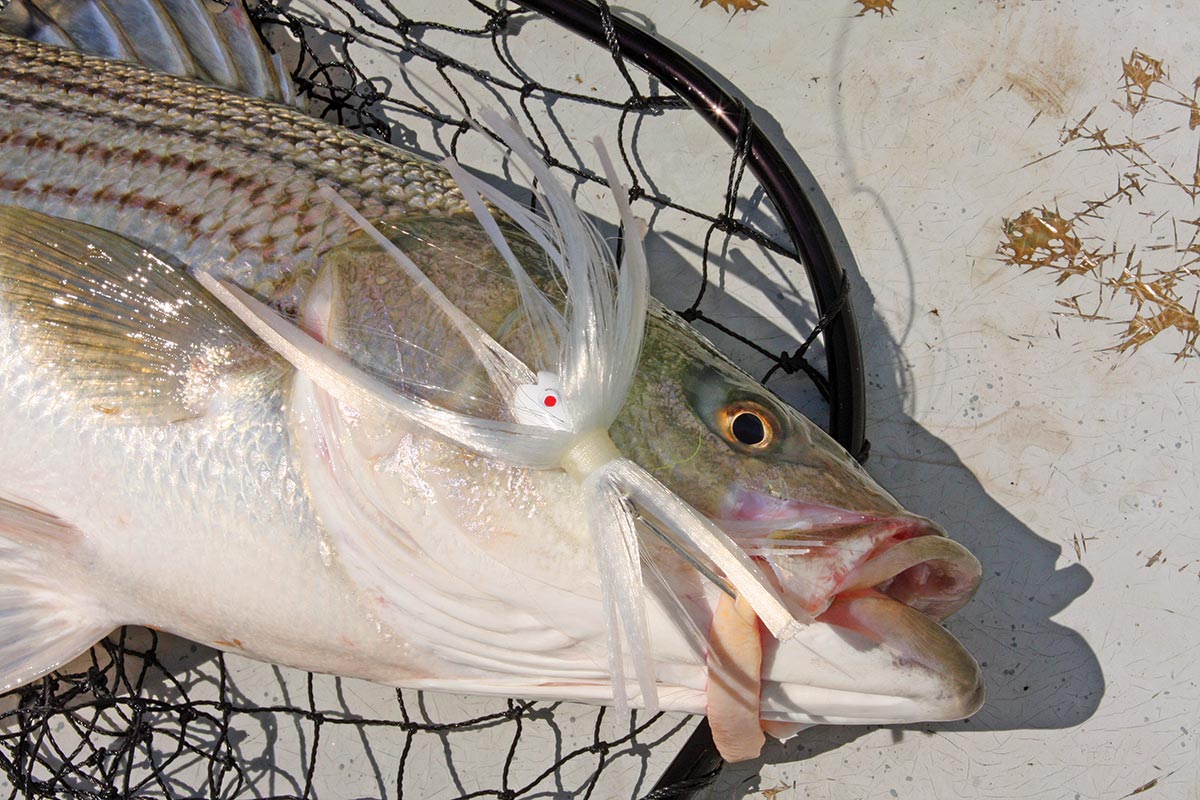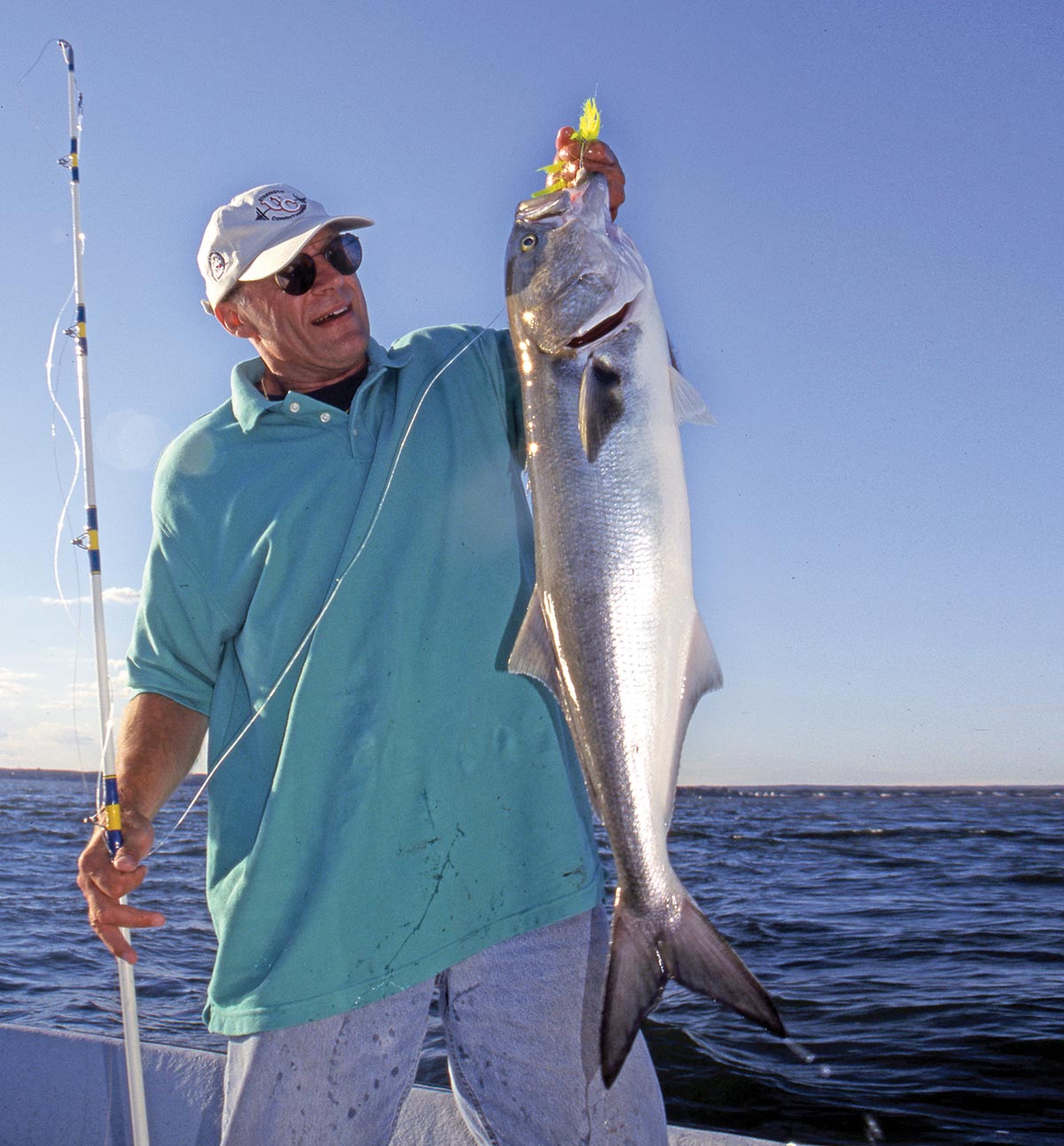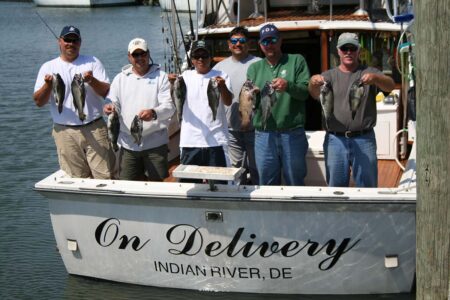
Small boats and light wire line outfits produce big summertime bass and blues.
In these days of light-tackle popularity, deep trolling wire line has earned a bad reputation with some fishermen. In their mind, wire lining implies exhausted anglers winching in seemingly endless miles of metal with big 4/0 workhorse reels—star drags maxed out—attached to extra-heavy-action rods. Equally exhausted, half-drowned fish are cranked to a boat still charging ahead at trolling speed.
There’s no doubt wire lining can be work. But it’s certainly one of the most effective means of hooking larger fish. For many charter captains it’s often the only way to ensure a successful trip. However, with a few minor changes to standard techniques you can make this very efficient method even more enjoyable. It starts with smaller boats fishing shallower water.
Bluefish, bass and weakfish inhabit skinny water just as often as they do deep water. But they need incentive—food or shelter—to hold them there. Reefs of only 15 to 25 feet deep offer both, which are common in western Long Island Sound. When talking about such thinly-masked rock piles you must scout your areas carefully and use common sense. With tide amplitudes of 7 feet in the western Sound, it’s obvious that what’s safe at high tide might be hazardous at low tide, so do your homework with a chart before heading out.
‘Chuting Across the Reefs
Slowly trolled parachute jigs—those lead-headed lures with colorful nylon fibers facing forward and rearward—are ideal for covering a lot of shallow ground while staying in the strike zone. But you need to know where to maneuver your boat to run the lures in the likeliest spots.
Fortunately, shallow rips make easy guides or “roadmaps” along which to troll. During slow current periods or when the wind and tide are opposing each other—and thus holding you in position—it’s easy to troll parallel to the reef just up tide of the rip line. But you’ll have to “stem the tide” if a strong current or wind is sweeping you into the rip.
“By stemming the tide,” said Capt. Ned Kittredge, a wire-lining pro out of Westport, Massachusetts, “which means moving diagonally into the flow of a strong current, you can keep your lures in the strike zone. On most days, the zone is on the slope just ahead of the crest of the reef, but on other days it’s on top of it. Current speed and the presence of bait, along with your experience on each reef, dictates the best location on a given day. Each reef has its own characteristics for attracting fish, and you need to put in your time to learn them.”
One notable trait of all shallow reefs, unlike the huge Race or Plum Gut, is that fish move readily from one structure to the next. When you’re planning a trip, try to have at least three or four reefs in mind. In western Long Island Sound we routinely cover 10 miles running from reef to reef until we find fish. If you make a half-dozen good passes in one place but don’t hook-up it’s time to try another spot.

Taking It Slow and Bouncing Bottom
Your lures need to run at the proper depth. Predators hang along the bottom even in shallow water. If you want to hook-up consistently your ‘chutes must run right along the reef.
“You need to hit bottom occasionally,” said Kittredge. “That way you’ll know your lure is in the strike zone, and the disturbance seems to attract fish. You’ll feel the bumps. The trick is not to get stuck in the rocks. When your lure hits a few times, immediately take about five fast turns in. If you’re still bumping hard, take another five. But if you’re trolling along and haven’t felt anything for a while you’re too high and should slowly let line out until the jig makes occasional contact.”
The best trolling speed is only about 2 to 3 knots, and at that speed you also don’t need to use as much wire. The deep trolling general rule is to run 10 feet of wire for every 1 foot of water depth. But we fish with about half that line ratio, which really adds to the sport.
Getting Wired and Rigging Out
If you’re new to wire lining, markers—usually made from wrapped, color-coded vinyl tape—determine line distance in 50-foot increments. The last 50-foot section ends at, say, 50-pound Dacron backing, connected by a small barrel swivel. Typical solid wire line is 40-pound test and made from Monel or stainless steel. Monel is a softer, heavier nickel alloy so it’s the better option, but it’s also more expensive. Stainless steel is lighter for its gauge and springier; therefore, it requires more attention when handling, especially for novices.
Using a small swivel (small enough to pass through the guides), I attach 15 to 20 feet of 60-pound mono leader to the working end of the wire. The long mono leader has several functions: First, the lure acts more naturally as it skips along a reef. Second, since wire has no stretch, it acts as a shock absorber during the strike and the fight to reduce pullouts. Third, when the mono is wound onto the reel it holds springy wire in place. Last, it’s easy on the hands when lifting a fish aboard. A simple clinch knot attaches the mono to the jighead.
The most productive parachute colors are chartreuse and white. Many experts tip jigs with a 7-inch red-and-white pork rind, which simulates a squid’s tentacles or a baitfish’s fluttering tail. In place of a pork rind, products such as Otter Tails and Fat Cow Jig Strips make great alternatives. Sometimes in skinny water, however, unadorned jigs outfish those with a long pork rind. I attribute this to the shortened length more closely simulating smaller forage.
Parachute jigs, of course, come in different weights. Typical deep-water trollers use lures of about 6 ounces. But along shallow reefs we use only 2- to 3-ounce jigs, which skim nicely over the rocks and don’t hang up as readily.

Getting Into The Action
Blues, bass and weakfish will certainly strike a straight-trolled jig. But to increase your hook-ups give your parachutes more action by holding the rod tip down to the water with the guides facing forward. Use a brisk, but not excessive, snapping or jigging motion, such as when sweeping a floor with short broom strokes. This causes the nylon jig fibers to open and close like an escaping squid and is an ideal application for a slow-action rod.
Good shallow-water wire-lining rods should be soft and have parabolic action to allow smooth lure movement yet have a substantial backbone at the base and braced tungsten carbide guides to prevent grooving. A blank rated for 20- to 40-pound line is an all-purpose choice. The soft tip gives a ‘chute a gentle motion while being easy on the wire so it doesn’t weaken and part prematurely, and a 7-footer gives you more “sweep” than a 6-1/2-footer. The classic deep-water wire-lining reel is the Penn 113H 4/0 Senator. However, such a large, heavy reel isn’t needed over shallow reefs. You can employ the lighter, smaller 112H2 3/0 Special Senator with great success. Similar, high-end star-drag reels, such as Shimano’s Torium 20HG, work extremely well with wire.
When a hook-up occurs in typical wire lining, the captain continues trolling so the other angler can keep fishing and doesn’t have to haul in 300 or more feet of line, but that means the fish is horsed in. Over shallow reefs, however, we only troll for a minute more to prompt a second strike. If none occurs, we throw the engine into neutral and enjoy the fight. The second angler, of course, must crank in his line to avoid hanging bottom, but with half the normal amount of wire out it’s not as much trouble. Wire-line trolling will never be light-tackle angling but hitting the shallows in summer is a bit more sporting than the deep-water option.



